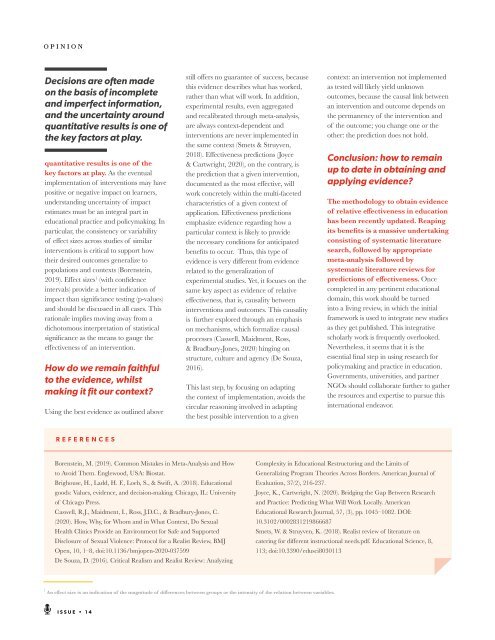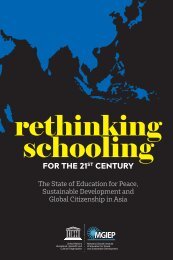The Blue DOT 14 - Multidisciplinary Science & Evidence For Education
Welcome to the 14th edition of the Institute’s flagship publication, The Blue DOT. In this edition, we bring to you news of the International Science and Evidence-based Education Assessment (ISEE Assessment) that the Institute embarked on about 18 months ago. The International Science and Evidence-based Education (ISEE) Assessment contributes to re-envisioning the future of education and feeds into UNESCO's Futures of Education report, today constituting over 250 authors from 70 countries. Read Opinion Pieces by thought-leaders, experts and academics, watch interviews with our advisory board members and explore the learnings of our research fellows while navigating experience of the Multidisciplinary Science & Evidence for Education.
Welcome to the 14th edition of the Institute’s flagship publication, The Blue DOT. In this edition, we bring to you news of the International Science and Evidence-based Education Assessment (ISEE Assessment) that the Institute embarked on about 18 months ago. The International Science and Evidence-based Education (ISEE) Assessment contributes to re-envisioning the future of education and feeds into UNESCO's Futures of Education report, today constituting over 250 authors from 70 countries. Read Opinion Pieces by thought-leaders, experts and academics, watch interviews with our advisory board members and explore the learnings of our research fellows while navigating experience of the Multidisciplinary Science & Evidence for Education.
Create successful ePaper yourself
Turn your PDF publications into a flip-book with our unique Google optimized e-Paper software.
OPINION<br />
Decisions are often made<br />
on the basis of incomplete<br />
and imperfect information,<br />
and the uncertainty around<br />
quantitative results is one of<br />
the key factors at play.<br />
quantitative results is one of the<br />
key factors at play. As the eventual<br />
implementation of interventions may have<br />
positive or negative impact on learners,<br />
understanding uncertainty of impact<br />
estimates must be an integral part in<br />
educational practice and policymaking. In<br />
particular, the consistency or variability<br />
of effect sizes across studies of similar<br />
interventions is critical to support how<br />
their desired outcomes generalize to<br />
populations and contexts (Borenstein,<br />
2019). Effect sizes 1 (with confidence<br />
intervals) provide a better indication of<br />
impact than significance testing (p-values)<br />
and should be discussed in all cases. This<br />
rationale implies moving away from a<br />
dichotomous interpretation of statistical<br />
significance as the means to gauge the<br />
effectiveness of an intervention.<br />
How do we remain faithful<br />
to the evidence, whilst<br />
making it fit our context?<br />
Using the best evidence as outlined above<br />
REFERENCES<br />
Borenstein, M. (2019). Common Mistakes in Meta-Analysis and How<br />
to Avoid <strong>The</strong>m. Englewood, USA: Biostat.<br />
Brighouse, H., Ladd, H. F., Loeb, S., & Swift, A. (2018). <strong>Education</strong>al<br />
goods: Values, evidence, and decision-making. Chicago, IL: University<br />
of Chicago Press.<br />
Caswell, R.J., Maidment, I., Ross, J.D.C., & Bradbury-Jones, C.<br />
(2020). How, Why, for Whom and in What Context, Do Sexual<br />
Health Clinics Provide an Environment for Safe and Supported<br />
Disclosure of Sexual Violence: Protocol for a Realist Review, BMJ<br />
Open, 10, 1–8, doi:10.1136/bmjopen-2020-037599<br />
De Souza, D. (2016). Critical Realism and Realist Review: Analyzing<br />
still offers no guarantee of success, because<br />
this evidence describes what has worked,<br />
rather than what will work. In addition,<br />
experimental results, even aggregated<br />
and recalibrated through meta-analysis,<br />
are always context-dependent and<br />
interventions are never implemented in<br />
the same context (Smets & Struyven,<br />
2018). Effectiveness predictions (Joyce<br />
& Cartwright, 2020), on the contrary, is<br />
the prediction that a given intervention,<br />
documented as the most effective, will<br />
work concretely within the multi-faceted<br />
characteristics of a given context of<br />
application. Effectiveness predictions<br />
emphasize evidence regarding how a<br />
particular context is likely to provide<br />
the necessary conditions for anticipated<br />
benefits to occur. Thus, this type of<br />
evidence is very different from evidence<br />
related to the generalization of<br />
experimental studies. Yet, it focuses on the<br />
same key aspect as evidence of relative<br />
effectiveness, that is, causality between<br />
interventions and outcomes. This causality<br />
is further explored through an emphasis<br />
on mechanisms, which formalize causal<br />
processes (Caswell, Maidment, Ross,<br />
& Bradbury-Jones, 2020) hinging on<br />
structure, culture and agency (De Souza,<br />
2016).<br />
This last step, by focusing on adapting<br />
the context of implementation, avoids the<br />
circular reasoning involved in adapting<br />
the best possible intervention to a given<br />
context: an intervention not implemented<br />
as tested will likely yield unknown<br />
outcomes, because the causal link between<br />
an intervention and outcome depends on<br />
the permanency of the intervention and<br />
of the outcome; you change one or the<br />
other: the prediction does not hold.<br />
Conclusion: how to remain<br />
up to date in obtaining and<br />
applying evidence?<br />
<strong>The</strong> methodology to obtain evidence<br />
of relative effectiveness in education<br />
has been recently updated. Reaping<br />
its benefits is a massive undertaking<br />
consisting of systematic literature<br />
search, followed by appropriate<br />
meta-analysis followed by<br />
systematic literature reviews for<br />
predictions of effectiveness. Once<br />
completed in any pertinent educational<br />
domain, this work should be turned<br />
into a living review, in which the initial<br />
framework is used to integrate new studies<br />
as they get published. This integrative<br />
scholarly work is frequently overlooked.<br />
Nevertheless, it seems that it is the<br />
essential final step in using research for<br />
policymaking and practice in education.<br />
Governments, universities, and partner<br />
NGOs should collaborate further to gather<br />
the resources and expertise to pursue this<br />
international endeavor.<br />
Complexity in <strong>Education</strong>al Restructuring and the Limits of<br />
Generalizing Program <strong>The</strong>ories Across Borders. American Journal of<br />
Evaluation, 37(2), 216-237.<br />
Joyce, K., Cartwright, N. (2020). Bridging the Gap Between Research<br />
and Practice: Predicting What Will Work Locally. American<br />
<strong>Education</strong>al Research Journal, 57, (3), pp. 1045–1082. DOI:<br />
10.3102/0002831219866687<br />
Smets, W. & Struyven, K. (2018). Realist review of literature on<br />
catering for different instructional needs.pdf. <strong>Education</strong>al <strong>Science</strong>, 8,<br />
113; doi:10.3390/edusci8030113<br />
Rebooting our relationship<br />
to technology: Insights from<br />
psychology into how we<br />
think about AI and EdTech<br />
in the aftermath of Covid-19<br />
John Sabatini is a Distinguished<br />
Research Professor in the Institute<br />
for Intelligent Systems and the<br />
Department of Psychology at<br />
the University of Memphis. He<br />
conducts research in educational<br />
technology, reading literacy<br />
development and disabilities,<br />
assessment, cognitive psychology,<br />
the learning sciences.<br />
Art Graesser is emeritus professor<br />
in the Department of Psychology<br />
and the Institute of Intelligent<br />
Systems at the University of<br />
Memphis. He conducts research<br />
in discourse processing, cognitive<br />
science, educational psychology,<br />
computational linguistics, and<br />
artificial intelligent in education.<br />
He developed AutoTutor, a system<br />
that helps people learn with<br />
conversational agents.<br />
JOHN SABATINI,<br />
ARTHUR GRAESSER<br />
Abstract<br />
In this article, we explore whether it<br />
is time we reconsider our relationship<br />
to technologies in education, both<br />
as individuals and societies. Multiple<br />
generations have now experienced<br />
different forms of digital devices and the<br />
functions and roles they play in society<br />
and education, layered upon traditional<br />
models of the role and function of<br />
education institutions. Over the same time<br />
period, we have learned a great deal from<br />
psychology about how human’s reason,<br />
make decisions, and learn. In this article,<br />
we review recent and emerging AI and<br />
1 An effect size is an indication of the magnitude of differences between groups or the intensity of the relation between variables.<br />
ISSUE • <strong>14</strong><br />
3 9

















